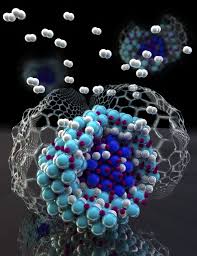
Improvement of Hydrogen Storage with Nanomaterials
Hydrogen is widely regarded as a clean and efficient energy carrier, essential for transitioning to a sustainable energy future. However, its storage remains a critical challenge that limits its widespread adoption. Nanomaterials, with their unique structural and chemical properties, offer innovative solutions for improving hydrogen storage. This article explores the potential of nanomaterials in revolutionizing hydrogen storage technologies.
Why Hydrogen Storage is Challenging
- Low Density:
- Hydrogen has a very low volumetric density, requiring compression or liquefaction for effective storage.
- High Energy Requirements:
- Traditional methods of compressing or liquefying hydrogen consume significant energy.
- Material Constraints:
- Current storage materials often suffer from low capacity, slow absorption/desorption kinetics, or high costs.
Nanomaterials for Hydrogen Storage
Nanomaterials offer several advantages for hydrogen storage due to their high surface area, tunable properties, and unique interactions with hydrogen molecules:
- Metal-Organic Frameworks (MOFs):
- MOFs are porous structures with exceptional surface areas, enabling high hydrogen adsorption capacities.
- Carbon-Based Nanomaterials:
- Materials such as graphene, carbon nanotubes (CNTs), and activated carbon are excellent for physical adsorption of hydrogen due to their large surface areas and lightweight nature.
- Metal Hydrides:
- Nanosized metal hydrides improve hydrogen absorption/desorption kinetics, reducing reaction times.
- Nanostructured Alloys:
- Alloys with nanoscale grains enhance hydrogen storage capacity and stability.
- Nanoporous Materials:
- Nanoporous silica and zeolites offer tailored pore sizes and high adsorption capabilities for hydrogen storage.
Advantages of Nanomaterial-Based Hydrogen Storage
- Enhanced Storage Capacity:
- Nanomaterials increase the amount of hydrogen stored per unit weight or volume.
- Faster Kinetics:
- Improved absorption and desorption rates enable more efficient hydrogen storage and release.
- Lower Operating Temperatures:
- Many nanomaterials operate at near-ambient temperatures, reducing energy consumption.
- Scalability:
- Advancements in nanomaterial synthesis allow for scalable production, making them viable for industrial applications.
Applications of Nanomaterials in Hydrogen Storage
- Transportation:
- Enables lightweight and efficient hydrogen storage systems for fuel cell vehicles.
- Renewable Energy Integration:
- Stores excess hydrogen generated from renewable sources like solar and wind for later use.
- Portable Power:
- Powers portable devices and off-grid energy systems with compact hydrogen storage solutions.
- Industrial Applications:
- Provides hydrogen storage for industrial processes and large-scale hydrogen refueling stations.
Challenges and Research Directions
- Cost:
- High production costs of advanced nanomaterials limit their widespread adoption.
- Durability:
- Ensuring long-term stability and resistance to degradation is critical for practical applications.
- Hydrogen Cycling:
- Maintaining performance over multiple absorption/desorption cycles remains a challenge.
- Safety:
- Addressing potential risks associated with hydrogen storage and nanomaterials handling.
- Optimization:
- Researching new nanomaterial compositions and structures to optimize hydrogen storage properties.
Future Directions
- Hybrid Systems:
- Combining nanomaterials with traditional storage methods to enhance efficiency.
- Artificial Intelligence:
- Using AI to predict and design nanomaterials with optimal hydrogen storage properties.
- Eco-Friendly Production:
- Developing sustainable and low-energy methods for nanomaterial synthesis.
- Global Collaboration:
- Fostering partnerships between governments, academia, and industry to accelerate commercialization.
Conclusion
Nanomaterials hold immense potential to revolutionize hydrogen storage, addressing key challenges of capacity, efficiency, and safety. By integrating nanotechnology into hydrogen storage systems, we can unlock the full potential of hydrogen as a clean and sustainable energy carrier. Continued research and innovation in nanomaterial science will be crucial in advancing hydrogen storage technologies and driving the global transition to renewable energy.
